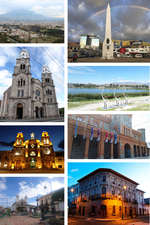32194°N 78.12167°W / 0.32194; -78.12167 The Inca-Caranqui archaeological site is located in the village of Caranqui on the southern outskirts of the city of...
9 KB (1,267 words) - 23:19, 17 August 2023
Cojitambo El Fuerte de Samaipata Huánuco Pampa Huchuy Qosqo Inca-Caranqui Llaqtapata Moray (Inca ruin) Oroncota Pambamarca Fortress Complex Písac Pukara of...
110 KB (12,873 words) - 18:11, 29 September 2024
Cara culture (redirect from Caranqui culture)
The Cara or Caranqui culture flourished in coastal Ecuador, in what is now Manabí Province, in the first millennium CE. In the 10th century CE, they followed...
6 KB (666 words) - 00:51, 26 September 2024
Pambamarca Fortress Complex (category Inca Empire)
although the Caranqui may not have been the most powerful of them. The Cayambe were the primary defenders who faced the advance of the Incas at the Pambamarca...
7 KB (945 words) - 10:46, 16 January 2024
Atahualpa (category 16th-century Sapa Incas)
that region, the Caranquis and the Cayambis. Together with his father and his brother, Ninan Cuyuchi marched at the head of the Inca army towards the...
44 KB (4,645 words) - 18:59, 29 September 2024
the area by the Inca Empire in the late 15th or early 16th century. The local chiefdom called the Caranqui fiercely resisted the Inca invasion of their...
3 KB (268 words) - 11:01, 13 January 2024
L. and Echeverría Almeida, José (2014), "The Late Imperial Site of Inca-Caranqui, Northern highland Ecuador at the End of Empire", Nampo Pacha, journal...
7 KB (877 words) - 14:59, 13 November 2023
Montubio 0.3% Other 0.1% Cotacachi Cayapas Ecological Reserve Cuicocha Inca-Caranqui, archaeological site Llurimagua Project Provinces of Ecuador Cantons...
8 KB (281 words) - 02:03, 10 September 2024
in Ecuador.[citation needed] The Inca ruler Atahualpa is said to have been born in the Inca settlement of Inca-Caranqui about 2 km from the city. Helados...
11 KB (555 words) - 02:53, 13 August 2024
derelict remains of perhaps the last imperial settlement of the Inca empire, Caranqui, harbors some evidence for significant hydraulic architecture. As...
17 KB (2,286 words) - 08:18, 22 August 2024
Quilago (category Inca Empire people)
became ruler of Cochasquí at a time when the Inca Empire was expanding northwards, into the lands of the Caranqui. As queen, Quilago formed a united front...
15 KB (1,656 words) - 03:47, 29 July 2024
Pukara (section Number and location of Inca pukaras)
chroniclers of Inca history. North of Quito, the Incas met stiff opposition from several chiefdoms, collectively called the Pais Caranqui. The Pambamarca...
5 KB (499 words) - 19:35, 31 March 2024
El Quinche (category Inca Empire)
over the Inca temple which became the shrine of El Quinche. El Quinche was the southernmost settlement of what was called the Pais Caranqui, a group of...
5 KB (480 words) - 15:39, 15 September 2023
List of wars involving Peru (section Pre-Inca (-1438))
María (Octubre del 2010). «3. Las etnias cusqueñas y los primeros incas». Incas. Biblioteca Imprescindibles Peruanos. Perú: Empresa Editora El Comercio...
86 KB (850 words) - 01:02, 21 September 2024
Rumicucho (category Inca Empire)
the Yumbo people to the east and the chiefdoms of the Pais Caranqui to the north. The Incas probably built Rumicucho between 1480 and 1500 and ruled this...
5 KB (575 words) - 22:01, 6 July 2023
Cochasquí (category Inca Empire)
of the Cara people and/or the Caranqui people. The Cara and the Caranqui may have been the same people. Prior to the Inca conquest in the late 15th century...
7 KB (796 words) - 20:19, 16 January 2024
Indigenous peoples in Ecuador (section Pre-Inca era)
Sierra region.[page needed] They are Quichua speakers and include the Caranqui, the Otavaleños, the Cayambi, the Pichincha, the Panzaleo, the Chimbuelo...
46 KB (5,714 words) - 04:12, 26 September 2024
Indigenous 8.8% Afro-Ecuadorian 8.7% White 3.8% Montubio 0.3% Other 0.2% Inca-Caranqui, archaeological site La Esperanza, Ecuador Yawarkucha Citypopulation...
4 KB (165 words) - 06:15, 28 August 2024
the Cayambis, the Caranquis, the Pastos and the other ethnic groups of the far north. However the revolt was put down by the Inca. In the early 21st...
8 KB (1,052 words) - 15:17, 13 June 2024
of the descendants of peoples conquered by the Incas, they are Kichwa speakers and include the Caranqui, the Otavalos, the Cayambe, the Quitu-Caras, the...
245 KB (24,815 words) - 00:36, 28 September 2024
wanted to evangelize. The thesis of the place as the center of the Inca and Caranqui cultures was reinforced after the archaeological studies carried out...
35 KB (4,107 words) - 10:27, 2 August 2024
characteristic place names), Panzaleo (sometimes classified as Paezan), Caranqui (until the 18th century, seemingly Barbacoan), and Pasto (Barbacoan). Apart...
10 KB (1,158 words) - 07:59, 19 July 2024
Ecuador Cañacure – Bolivia Capueni – Brazil Capua – Brazil Cara (Scyri, Caranqui, Otavalo) – Ecuador; possibly Barbacoan Carabayo (Yuri, "Amazonas Macusa")...
53 KB (5,880 words) - 18:53, 8 June 2023















